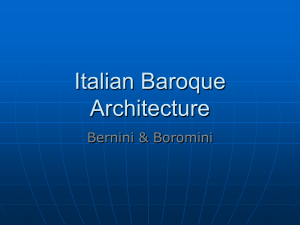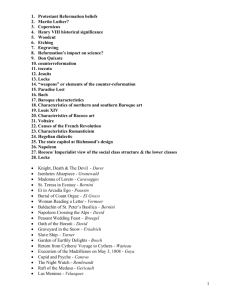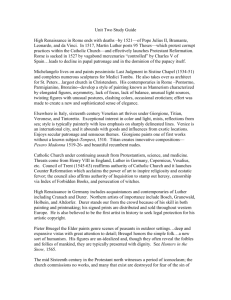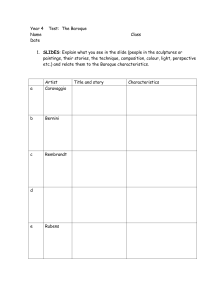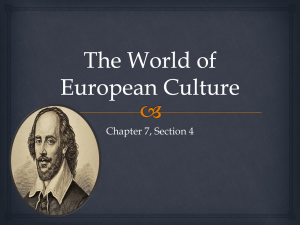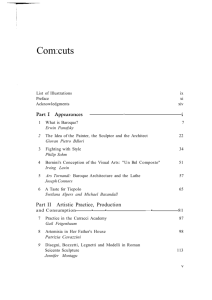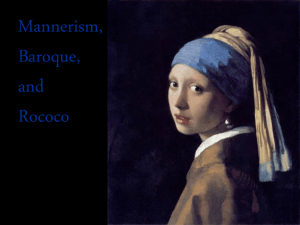Chapter 24 - Baroque y
advertisement
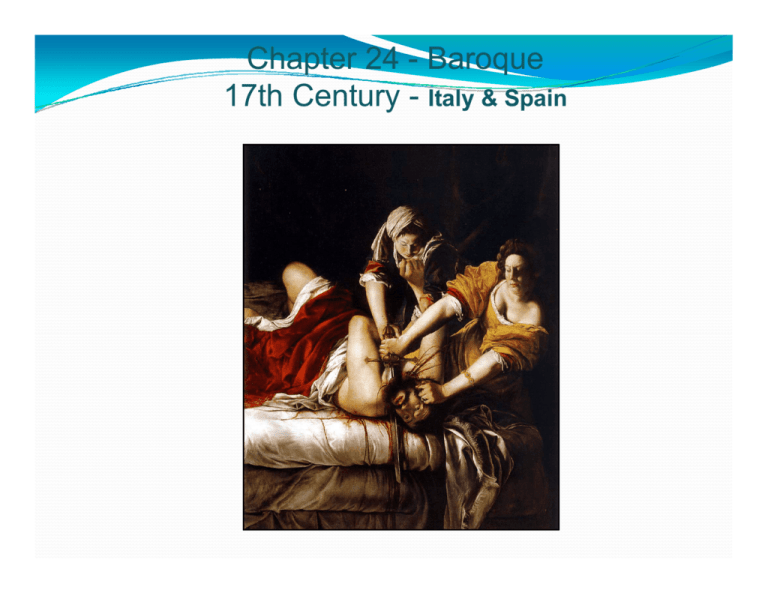
Chapter 24 - Baroque 17th Century y - Italyy & Spain p 17th Century - Italy & Spain Gardner’s 12th ed., Chapter 24, multimedia cd Key ideas y The term “Baroque” means irregularly shaped” or “odd,” a negative work that evolved in the 18th century t d to describe the Baroque’s departure from the Italian ib th B ’ d t f th It li Renaissance. y The Counter‐Reformation, which symbolized the The Counter‐Reformation which symbolized the Catholic resurgence, finds an artistic parallel in Baroque art. y Baroque artist experiment with different art forms, such as genre paintings, landscapes, and still‐life paintings. They bring them artistically to the same i ti Th b i th ti ti ll t th level as traditional subjects. y Baroque architecture is associated with the majestic royal courts of Europe. St. Peter’s Plan Comparison Bramante, 1505 Michelangelo 1546 Maderno 1606-12 Cue Card 24.-3:Carlo Maderno, Facade of Saint Peters, 1607-1612, Rome •Façade and Nave added to Michelangelo’s design of St. Peter’s, making a Latin cross plan •Wide and low façade: originally conceived with flanking bell towers that were never completed above the façade level •Emphasis on the center of the façade with pediment highlighting the main door •Pilasters on each en gradually become rounded engage columns around the central door Aerial view of Saint Peter’s Bernini’s, Colonnade of Saint Peter Bernini s, Colonnade of Saint Peter y Huge plaza that can hold half a million people y Bernini wanted a surprising transition between the crowded streets of Rome and the giant vista of St. Peter’s y Colonnade acts as a C l d dramatic gesture of embracing arms, g symbolically brings the faithful into the building y Shaped like a keyhole; St. Shaped like a keyhole; St Peter holds the keys to the kingdom of heaven 24-5: Gianlorenzo Bernini, Baldacchino, 1624-1633, bronze, Saint Peter’s, Vatican City, Rome Cue Card y Over the main altar of St. y y y y y Peter’s, four twisting corkscrew columns that spiral upward Acts as a shrine and canopy over the grave of Saint Peter, buried under the basilica Bees and suns appear prominently on top corners; symbols of the patrons, Barberini family Symbol of the Counter‐ R f Reformation spirit ti i it Feat of bronze casting Directs viewer’s vision down the Directs viewer s vision down the nave of Saint Peters Baldacchino – a canopy placed over an altar or a shrine Cue Card Baldacchino Cue Card • In mid‐action, swinging the • • • • • slingshot a shepherd's weapon slingshot, a shepherd s weapon, at Goliath – the most dramatic moment H D id’ f Harp at David’s feet symbolizes b li his role as a musician that he had to give up when he fought Bernini’s idealized self‐portrait in the face of David; intensive gaze Meant to be seen from multiple views Its unrestrained action demands space around it. space around it Use of negative space animates sculpture and surroundings 24‐6: Gianlorenzo Bernini, David, 1623, marble, 5’7” Bernini, David Cue Card Intense concentration on David’s David s face Compare Diskobolos Donatello’s David Verrocchio’s David Michelangelo’s David Bernini’s David Cue Card •A sculptural interpretation of Saint Theresa’s diary in which tells of her visions of God, many involving an angel descending g g g with an arrow and plunging it into her •Natural light redirected onto the g sculpture from a window hidden above the work •Marble handled in a tactile way y to reveal textures; skin is high gloss, feathers of angel are rougher, drapery is animated and fl d l d fluid, clouds are roughly cut hl •Figures seem to float in their space, with the rays of God’s light symbolically illuminating the b li ll ill i i h scene from behind 24-7: Bernini,, Ecstasy y of Saint Teresa, 1645-1652, marble, Santa Maria della Vittoria, Rome, 11’6” S i t Th ’ t y Saint Theresa’s pose suggests exhaustion, a feeling that is consistent with her description of spiritual ecstasy described in her i it l t d ib d i h diary entries y Passionate drama y Stagelike setting with the patrons, members of the Cornaro family, s sitting in theatre boxes looking on g ea e bo es oo g o and commenting – theater for production of this mystical drama y He used full capabilities of architecture, sculpture, and painting to charge the entire chapel with tension. chapel with tension 24-9: Francesco Borromini, San Carlo alle Quattro, 1638-1641, Rome Cue Card It iis on th ith th •It the square with the four fountains •Alternating convex and concave patterns and undulating volumes in ground plan and façade •Façade Façade higher than the rest of Dome the building •Interior side chapels merge into central space •Walls treated sculpturally •Borromini worked in shades of white, avoided colors used in many Baroque buildings •Interior dome oval shaped and coffered San Carlo alle Quattro Dome Undulating Façade/motion – crating a dynamic counterpoint of concave and convex elements on two levels . He enhanced the three dimensional effect with deeply recessed niches. Cue Card Greek cross hybrid Chapel of Saint Ivo •Barrel Barrel vaulted ceiling combines “quadro ripportato” (framed paintings) and “di sotto in su” painting – resembling easel paintings on a wall •Idealized bodies in a variety of poses •Commissioned C i i d to t celebrate l b t the th wedding of the cardinal’s brother. •Vigorous movements •Rich color •Figures overlap the painted and stucco frames, frames sitting on them them, putting their hands over them •Rich colors inspired by the Venetians Cue Card 24-16: Annibale Carracci Loves of the Gods, Palazzo Farnese, 1597-1601 C ili frescoes f Ceiling Quadro riportato Chiaroscuro = light g 24-17: CARAVAGGIO Calling of St. Matthew Ca. 1597-1601 Oil on canvas Cue Card Calling of St. Matthew Conversion of Saint Paul Tenebrism = violent contrasts of light and dark. Chiaroscuro is part of it. •Light comes in from two sources of light, creating a tenebroso effect on figures •Diagonal shaft of light points directly to Saint Matthew, who points to himself as if unsure that Christ would select a tax collector, depicting a moment in time. •Christ’s Ch i t’ hand h d gesture t is i similar i il to t Adam’s Ad ’ on the Sistine Chapel ceiling •The moment in which Christ inspires him to follow him. him •Dressed in latest Baroque fashion •Narrow stage for figures to sit and stand •Only slight suggestion of halo on Christ’s head indicates sanctity of the scene •Sensual figures, everyday characteristics •Naturalist approach to Baroque •Christ’s body placed in a grave; painting placed over an altar so Christ is symbolically b li ll being b i placed l d on the altar •Figures pushed forward toward the picture place •Stone slab seems to come forward into our space •Nicodemus(figure Nicodemus(figure looking at us) said be Caravaggio Caravaggio, Entombment Chapel of Pietro Vittrice, Santa Maria in Vallicella Rome, Italy, ca. 1603, oil on canvas 9 ft. 10 1/8 in. x 6 ft. 15/16 in. 24-19: Artemisia Gentileschi Judith slaying Holofernes 1614-1620, oil on canvas Cue Card I fl f C i i y Influence of Caravaggio in y y y y the tenebrism and gory details D Dramatic lighting, i li h i emotional pathos Face of Judith a self‐ J portrait, the artist identified with Old Testament heroines; She was raped by a male teacher‐an event that went to trial She specialized in painting images of women triumphing over men Reni, Aurora ceiling in the Casino Rospigliosi •Classicist trend in painting •Quadro riportato •Influenced by Raphael •Soft modeling, sweet airy vision Aurora leads Apollo's •Aurora chariot, Cupid and the Seasons dance about the heavenly car 24-22: Pietro da Cortona, Triumph of the Barberini, 1633-1639 Ceiling fresco in Gran Salone, Palazzo Barberini, Rome Cue Card •Naturalist trend in painting •Symbols of the Barberini family include the bees and laurel wreaths •Figures move easily in an open space unified by extensive use of light and color •Ceiling subdivided by a painted architectural framework that figures spill over •Divine Providence appears in a halo of light directing immortality, holding a crown of stars, to bestow eternal life on the family of Pope Urban VIII Fra Andrea Pozzo, Glorification of Saint Ignatius Triumph of the name of Jesus Spain Diego Velazquez, Water Carrier of Seville, 1619, oil on canvas • Early work of Velazquez h i i shows intense interest in Caravaggio tenebrism • Deceptively simple D ti l i l genre scene has a sacred quality about the expressions the the expressions, the handling over of the glass, clarity of the water • Rounded volumes of the foreground figures, the water jug j g • Water is sweetened by the fresh fig placed for flavor •Imaginary landscape of Breda tenderly rendered in the background; a cross is formed in a distant lake-symbolic of Catholic domination over Protestant forces. •Soldiers’ S ldi ’ mutual t l respectt in i honoring the valor of the other side •Open space in center of painting emphasizes the keys and the symbolism of a city resigned •Velazquez Velazquez never met the Dutch, nor had he been to Breda Diego Velazquez, Surrender of Breda •Depicts the 1625 episode in which the Dutch were forced to y yield the town of Breda to the Spanish •Stresses the graciousness of the Spanish victors, militarily dignified, a uniform fight force, magnanimous in victory •Dutch on left: more scattered, less organized, youthful •Spanish weapons arrayed to symbolize military might of victors; Dutch weapons appear less organized and inconsequential 24-30: Diego Velazquez, Las Meninas 1656, oil on canvas, 10’5” X 9’ Cue Card y Group portrait of the artist in his studio at work; he steps back f from the canvas and th d looks at the viewer y Velazquez wears the cross of the Royal Order of Santiago, elevating him to knighthood y Painting hung in Philip IV’s study Cue Card Diego Velazquez, Las Meninas y King and queen appear in a mirror But what is the mirror mirror. But what is the mirror reflecting; Velazquez’s canvas? They have turn around or is it a reflection? y Alternating darks and lights draw us deeper into the canvas; the mirror h i simultaneously reflects out into our space. y Dappled effect of light on shimmering surfaces. y Cunning contrast of real, mirrored, and picture space, to elevate both himself and the profession of painting in the eyes of Philip IV Summary y The Baroque has always symbolized the grand, the majestic, the colorful, and the sumptuous in European art. art y It is characterized by a sense of ceaseless movement y Caravaggio and Gentileschi, use dramatic contrast of Caravaggio and Gentileschi use dramatic contrast of light and dark to highlight the movement of the figures g y The Baroque achieves a splendor through an energetic interaction reminiscent of Hellenistic Greek art, which serves as its original role model. i i i l l d l
